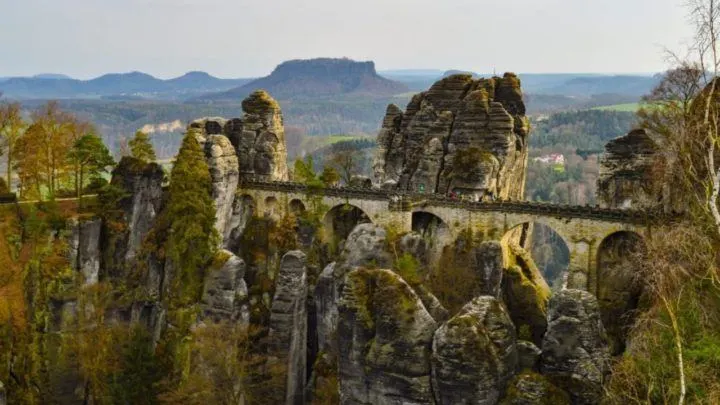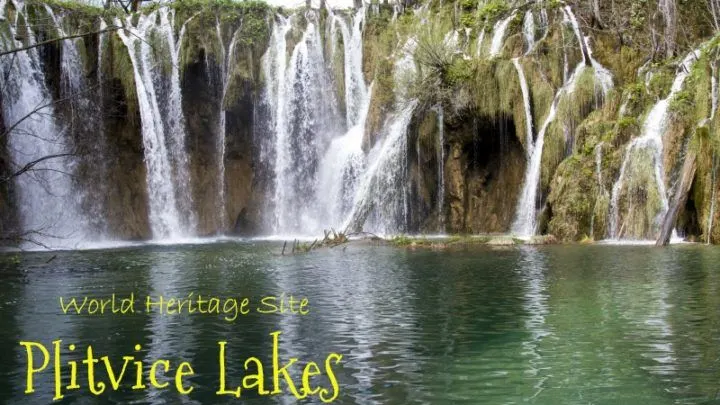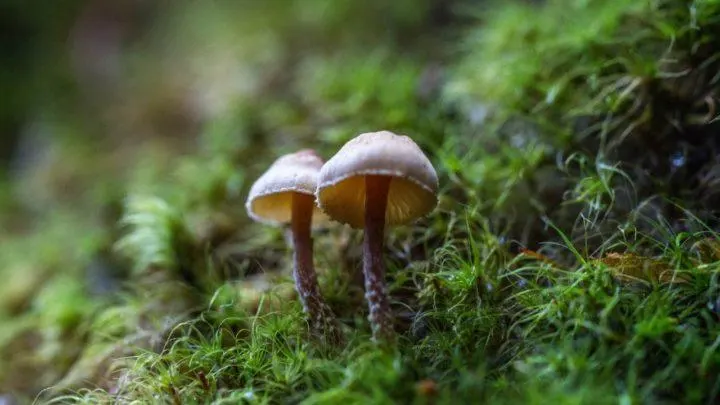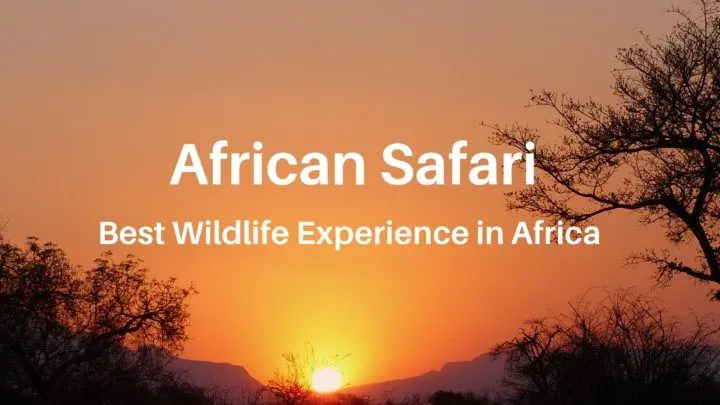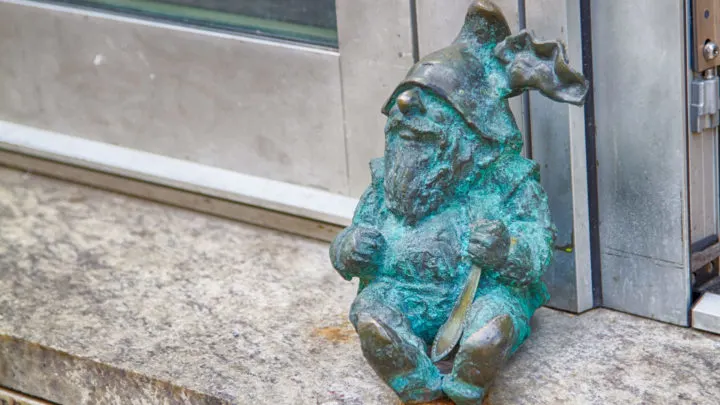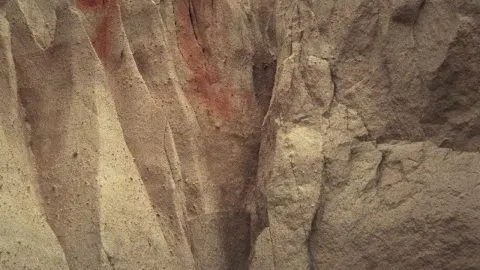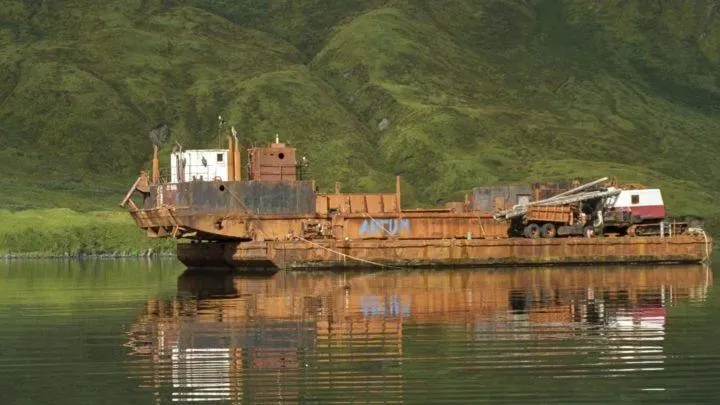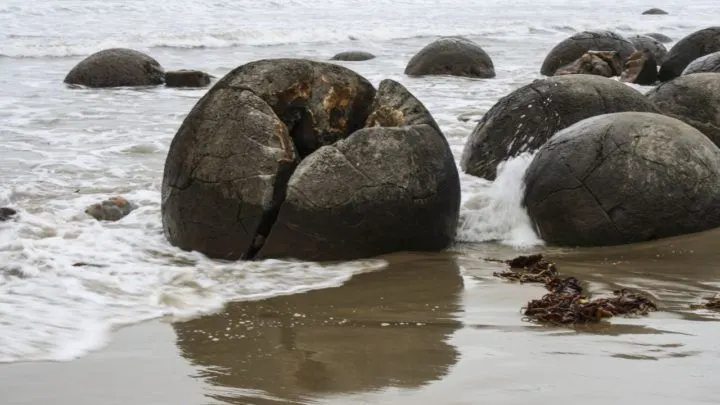Do you love waterfalls? Would you swim in a deep clear pool below a huge waterfall? Australia’s Litchfield National Park has several gorgeous waterfalls, lots of scenic trails, and unusual termite mounds.
This is the beginning of a once-in-a-lifetime trip to the Top End and Red Centre of Australia. After, linking up with my Australian family in Victoria, we flew to Darwin and spent three days looping through Litchfield and Kakadu National Parks. Then we boarded The Ghan for a trip through the outback. Litchfield National Park, with its spectacular waterfalls, proved to be the perfect place to start this journey.
We have family living “down under,” and that was the great instigator that initially got us to Australia. Once we visited, we discovered the country is as fascinating, as exotic, as we always thought and hoped it would be. We’ve all taken trips to Australia, and I’m sure we’ll continue to do so!
Additional articles from this trip are Kakadu and Uluru-Kata Tjuta National Parks. This article is about Litchfield National Park where we visited gorgeous waterfalls, crystal clear plunge pools, and amazing termite mounds:
This article is about:
- Wangi Falls: walked to the plunge pool below this beautiful, double waterfall. It’s reason enough to visit Litchfield National Park.
- Greenant Creek and Green Ants: we walked part of the trail (toward Tjaetaba Falls) and even found and took photos of green ants.
- Tolmer Falls: walked to the viewing platform overlooking the falls.
- Florence Falls: had a gorgeous view of the falls and plunge pool from the viewing platform.
- Termite Mounds: followed the boardwalk through magnetic termite mounds and stopped at some very large cathedral termite mounds.

About Litchfield National Park
Litchfield is about a 90-minute (120 km) drive south of Darwin. The park covers approximately 1,500 km2 and has waterfalls, waterholes, monsoon forest walks, bushwalks, termite mounds, birdwatching, and other wildlife.
We were only in Litchfield for a few hours, so we focused on seeing waterfalls and termite mounds. But there’s so much more and you could easily spend a couple of days here.
Open: The park is open year-around, although some sights are seasonal and some require 4WD.
Time needed: Half day: see the major waterfalls and stop by the termite mounds
Full day: include a plunge pool swim and monsoonal forest walk to Tjaetaba Falls
Two full days: take more forest and bush walks and see all of the waterfalls
Location: Northwest Territory, Australia about 120 km south of Darwin
Links: Northern Territory Litchfield NP and Fact Sheet and Map
Park Information About Visitor Access
Signs like this at Wangi Falls are located around the park, so visitors know what is or is not open:
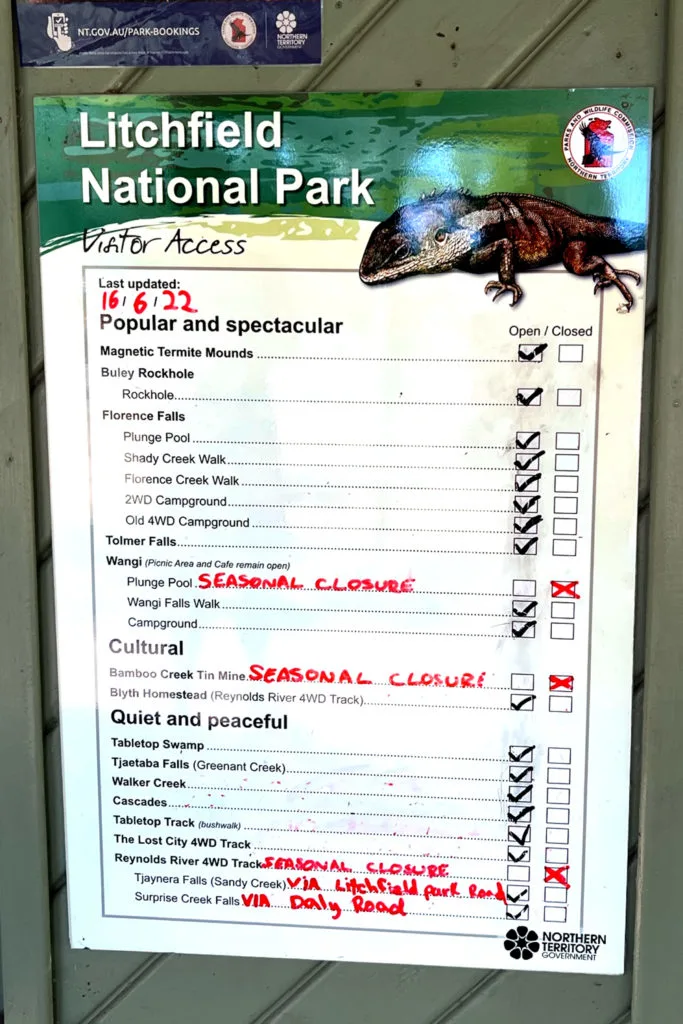
Google Map
Click the map image below to go to the expandable, interactive Google Map with our route through Litchfield and Kakadu National Parks plotted and locations pinned. The pins have brief descriptions:
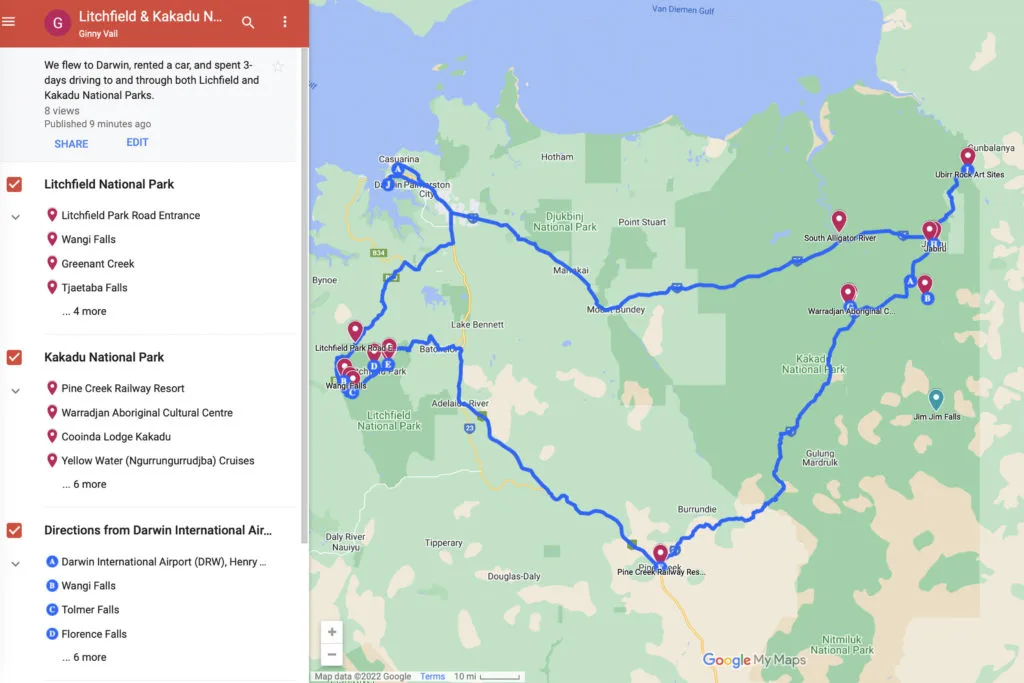
Best Time to Visit Litchfield National Park
The best time to visit depends a lot on what you want to see and do. If your top priority is seeing the waterfalls at their peak, come during the wet season (November to April). If you really want to swim in the waterholes or the plunge pools below the falls, wait until the dry season (May to October) when trails are more accessible and any saltwater crocodiles have been removed.
We were there in mid-June, which is early dry season and the beginning of winter. It was sunny and warm but not too hot or humid There was significant water flowing over both Wangi and Florence Falls, and they were spectacular.
Litchfield National Park is open all year, but parts of the park are seasonal and some are only accessible with 4-wheel drive.
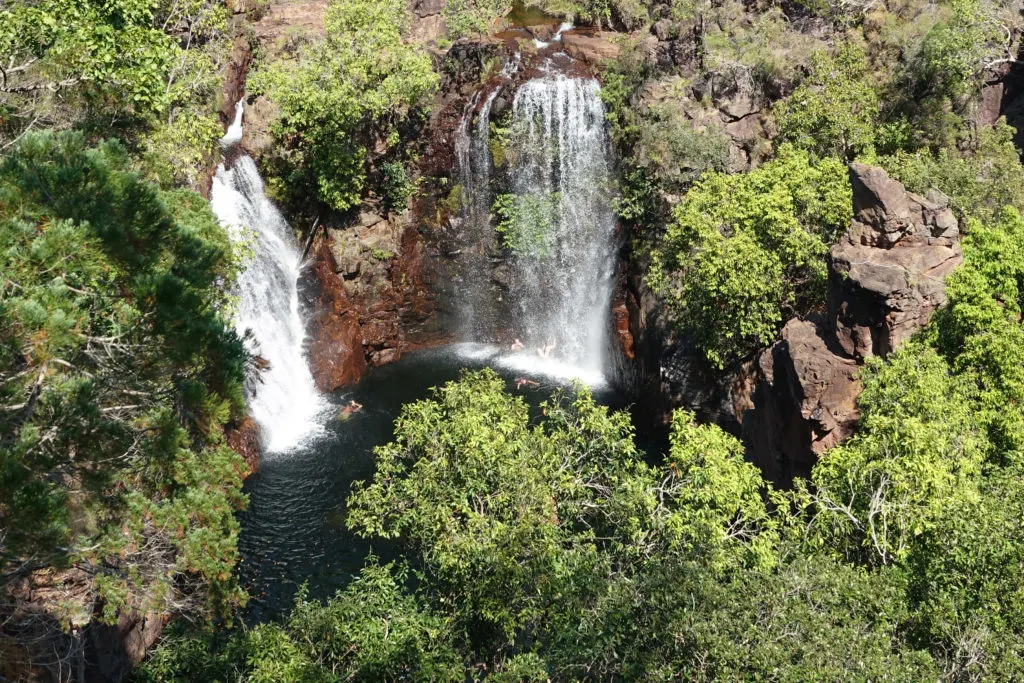
The plunge pool below Wangi Falls was closed to swimming, but the one at Florence Falls was open and there were plenty of people taking the plunge.
There are freshwater crocodiles in creeks and pools, but “freshies” are not aggressive or dangerous. During wet season, when the water is higher, saltwater crocodiles can get into the creeks too. The “salties” are dangerous and have to be removed from the plunge pools and water holes before people are allowed to swim.
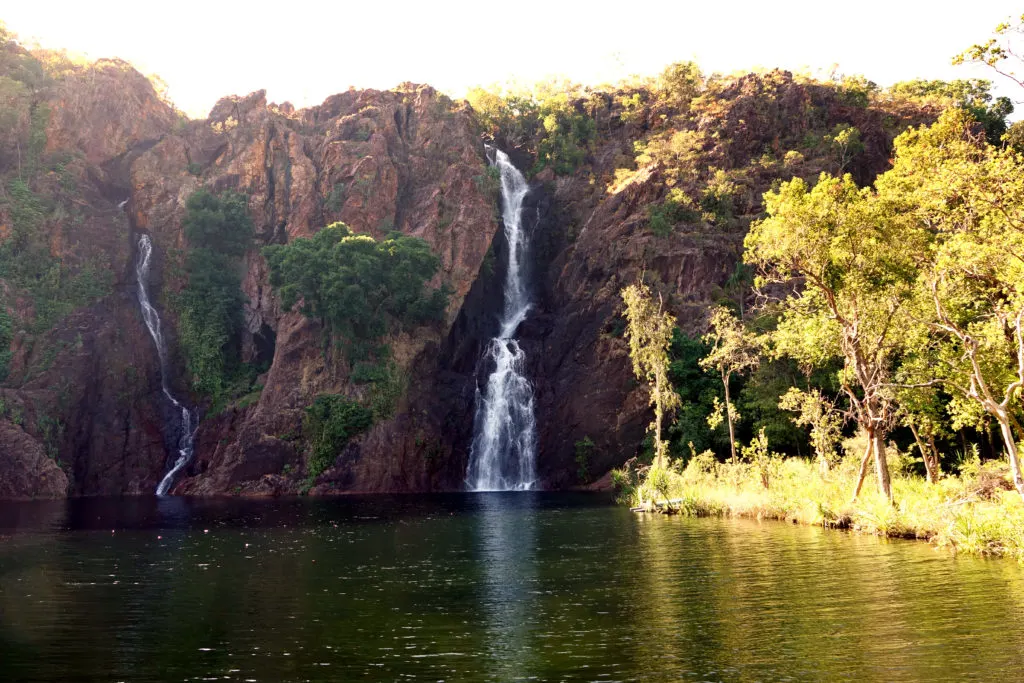
Is Litchfield National Park Free?
The park is free but campsites and multi-day bush walks have fees. Book and pay for them online in advance.
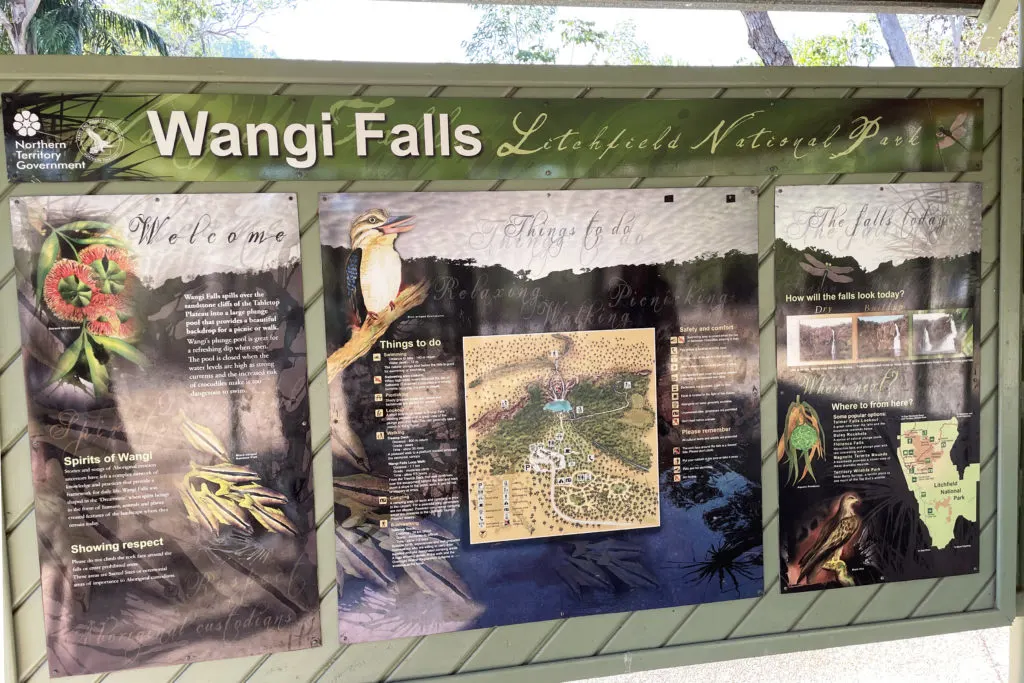
Wangi Falls
Wangi Falls are the most popular attraction in Litchfield National Park. The falls are open all year and are easily accessible. It’s only about 70 meters from the car park to the viewing platform at the base of the falls.
There are two other walks at Wangi Falls. An 800 m (round trip) walk to a Treetop Deck overlooking the forest canopy and a 1.7 km Wangi Loop walk the continues beyond the Treetop Deck to the plateau behind the falls.
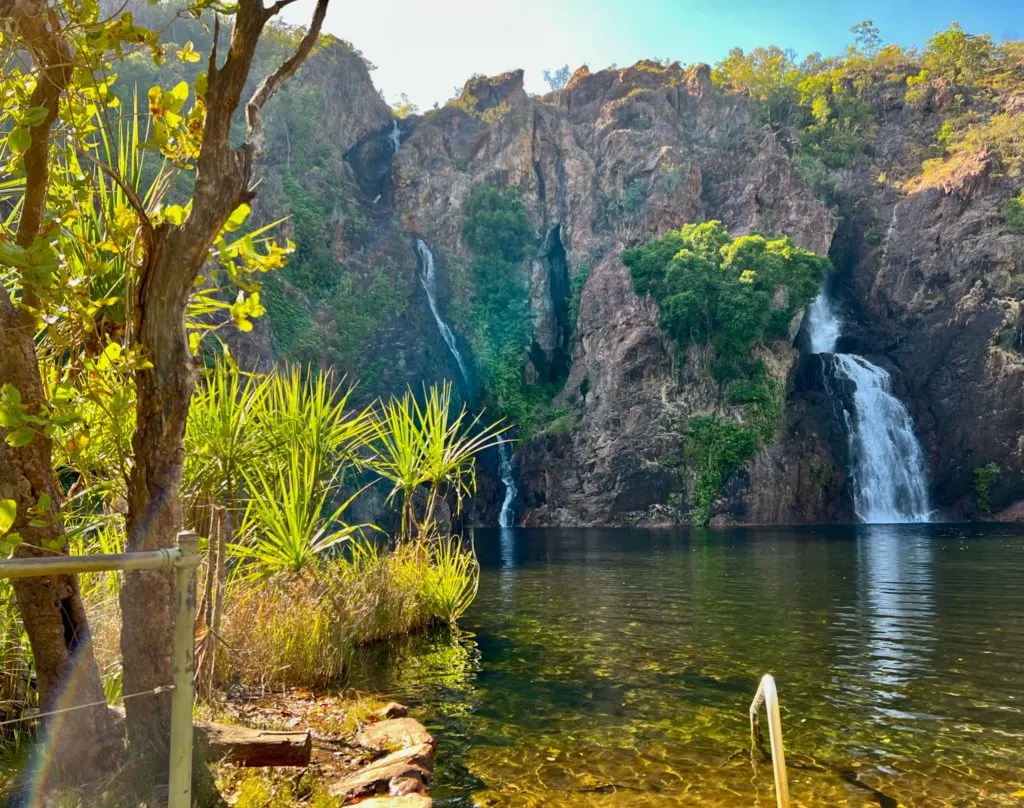
During our visit, the pool at the base was still closed to swimming. We don’t know if this was because so much water was flowing over the falls or because of crocodiles — or both. In any case, there was a spectacular amount of water pouring over the sandstone cliffs of Tabletop Plateau, and the water in the plunge pool was beautifully crystal clear.
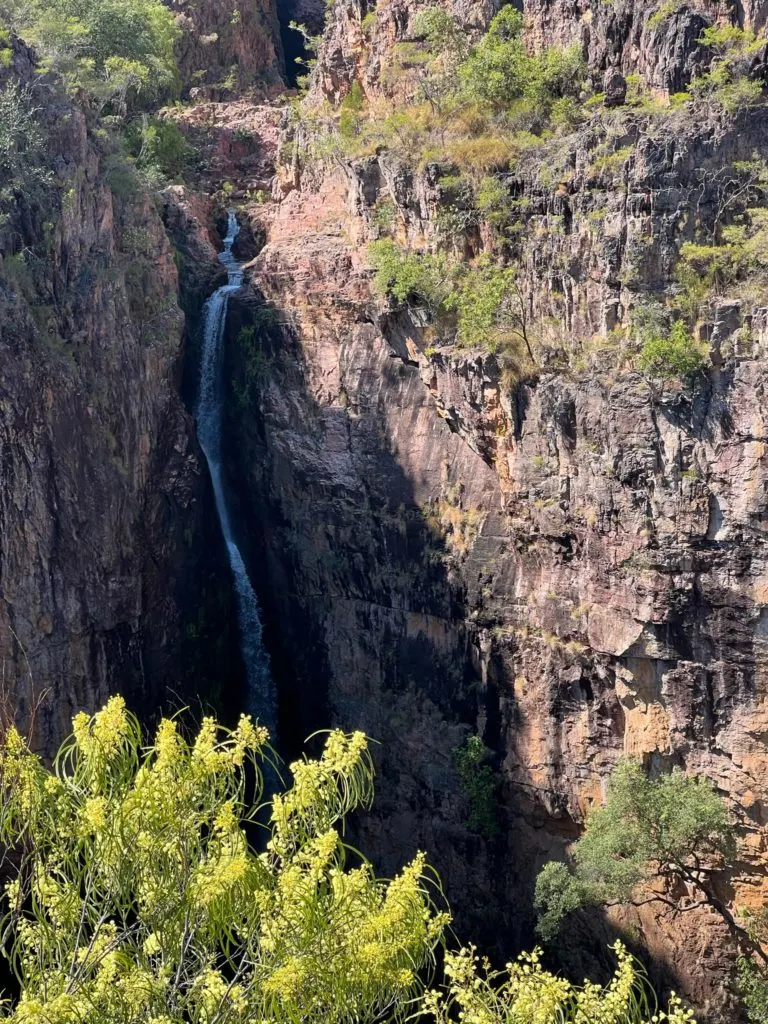
Tolmer Falls
There are two walks at Tolmer Falls, but they share the same view of the falls. Both trails go to a pair of viewing decks. The first deck is 500 m (round trip) and looks out over the valley. The second deck has a clear view of the falls and the pool below and is 800 m (round trip):
- Lookout walk: take the 800 m walk to the second viewing platform at the top of the gorge overlooking the falls. The second deck has a clear view of the falls.
- Tolmer Falls Loop walk: the loop walk is 1.6 km, takes 45 minutes, and is rated moderate. This trail also goes to the viewing deck but provides an alternate route back to the car park. From the viewing deck, the loop walk continues along the escarpment and Tolmer Creek.
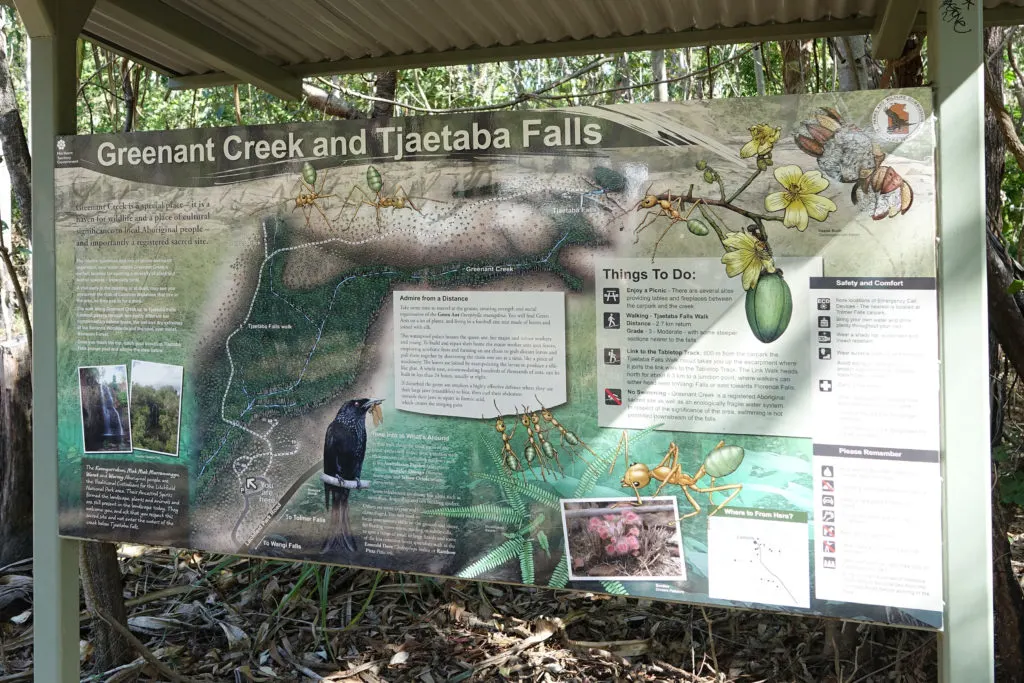
Greenant Creek and Tjaetaba Falls
The walk from Greenant Creek to the lookout at the top of Tjaetaba Falls is a 2.7 km return track and takes about 1.5 hours. The trail wanders through a lush Monsoon Forest near the creek and then through Savanna Woodlands. It’s rated moderate but gets steeper and rockier near the falls.
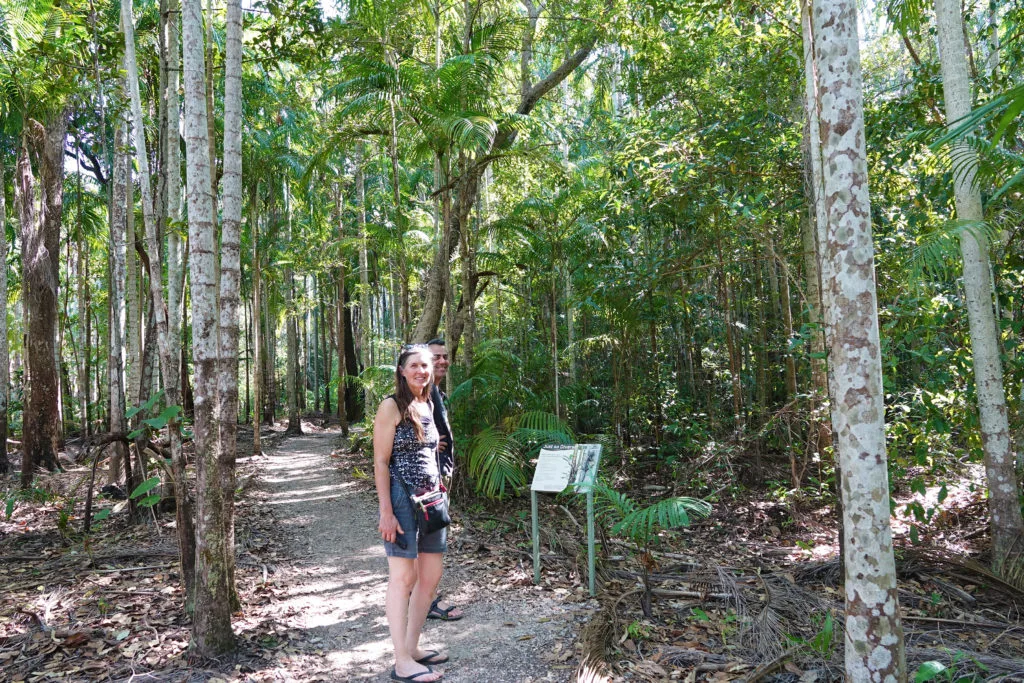
We, unfortunately, only had time to walk part of the Greenant Creek and Tjaetaba Falls trail and did not go all the way to the falls. The part we walked was heavily wooded, very green, very peaceful, and we did see and take photos of green ants.
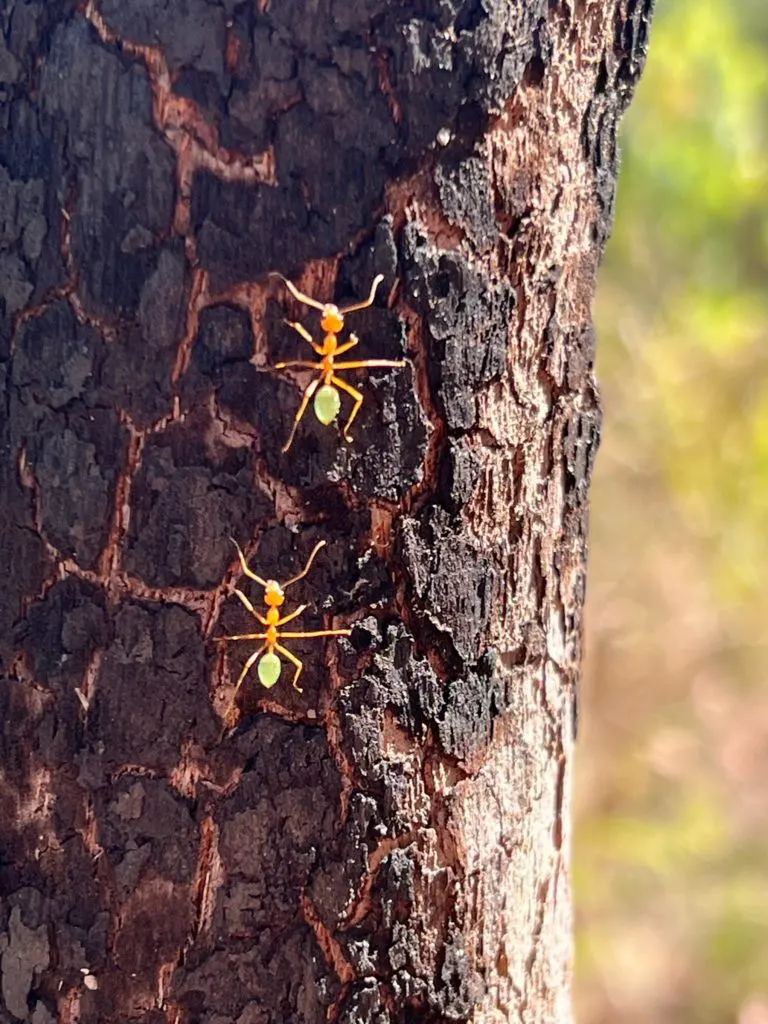
There Really Are Green Ants Along Greenant Creek
Don’t be fooled by their lovely shade of green. If disturbed, these cheeky little blighters will bite you and then squirt formic acid into the wound.
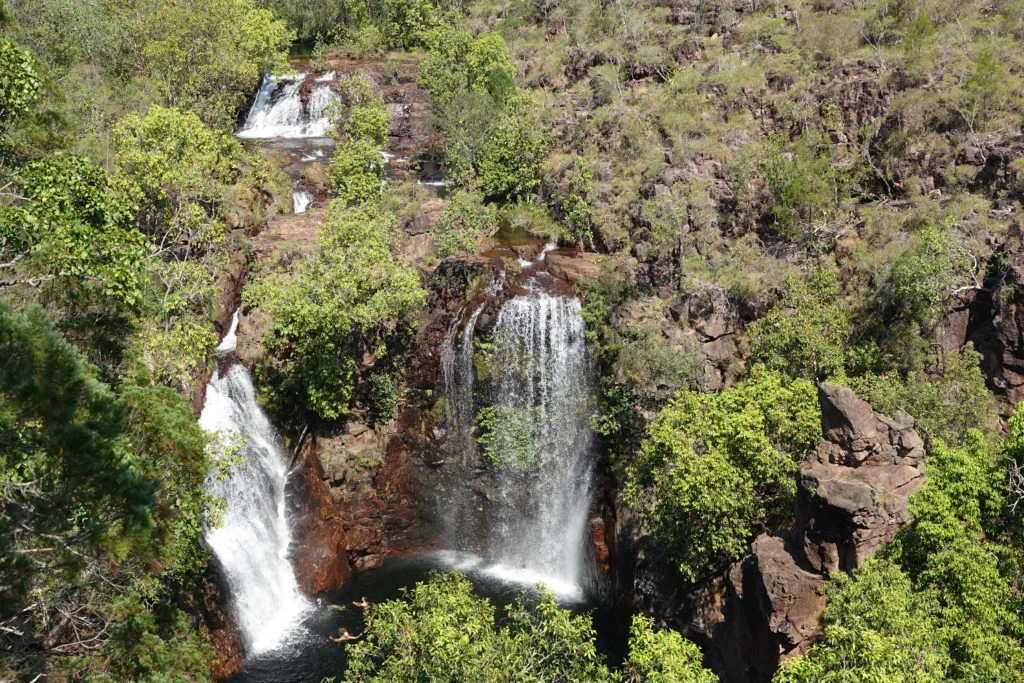
Florence Falls
This is a gorgeous waterfall with multiple sections cascading and then dropping into the pool below. The plunge pool was open and there were busloads of people (on day trips from Darwin) hiking up and down the trail. The swimmers came prepared with swimsuits, beach towels, and some even had floating devices. It’s not for the faint of heart though because the shortest path down is 160 steps.
The scenic viewing platform is perfectly positioned for a clear view of the gorge, the falls, and the pool below. And it’s only a 3-minute walk from the car park.
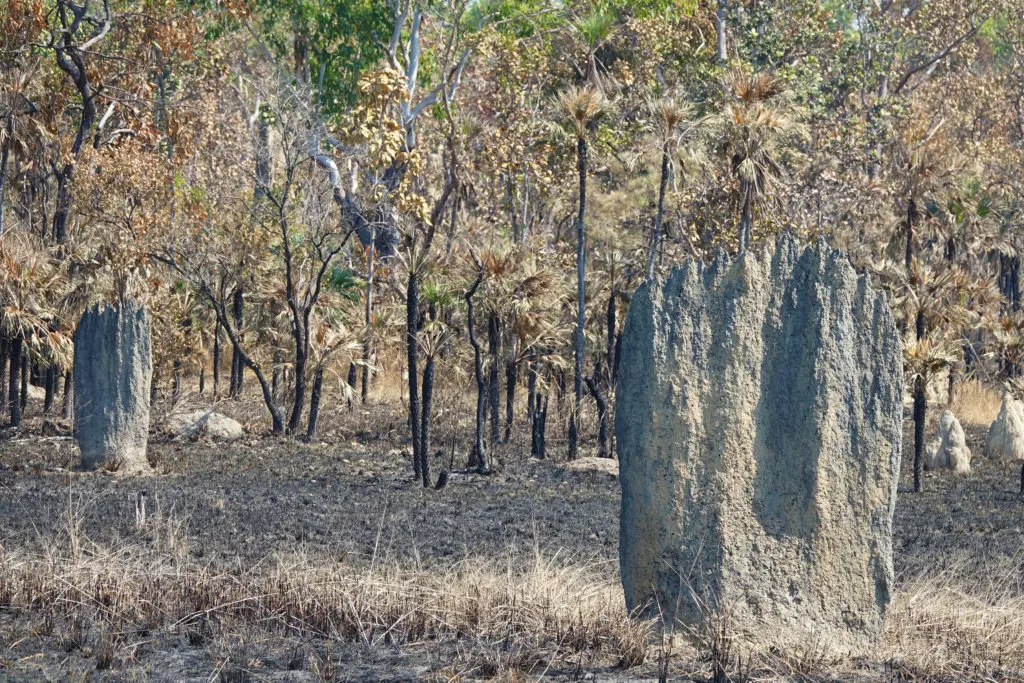
Magnetic Termite Mounds and Cathedral Termite Mounds
There are both magnetic and cathedral termite mounds in Litchfield and they are intermingled. Oddly they look very different, different size, different shape, and even a totally different color.
Magnetic Termite Mounds
Stop at the Magnetic Termite mounds and walk out on the boardwalk. There are many dozens of mounds here, and because of their odd shape and orientation, it looks a bit like a graveyard, especially since the area had recently burned. The mounds can be 2 meters high and 100 years old.
These clever termites build wedge shaped mounds that are thin in one directions and wide in the other. They orient the mounds so the thin ends point north and south and the wide sides face east and west. The east-west exposure for the mounds helps regulate the temperature because one side is always shaded.
I’ve found nothing that explains how these termites align their mounds to the earth’s magnetic field, but they obviously have north and south figured out.
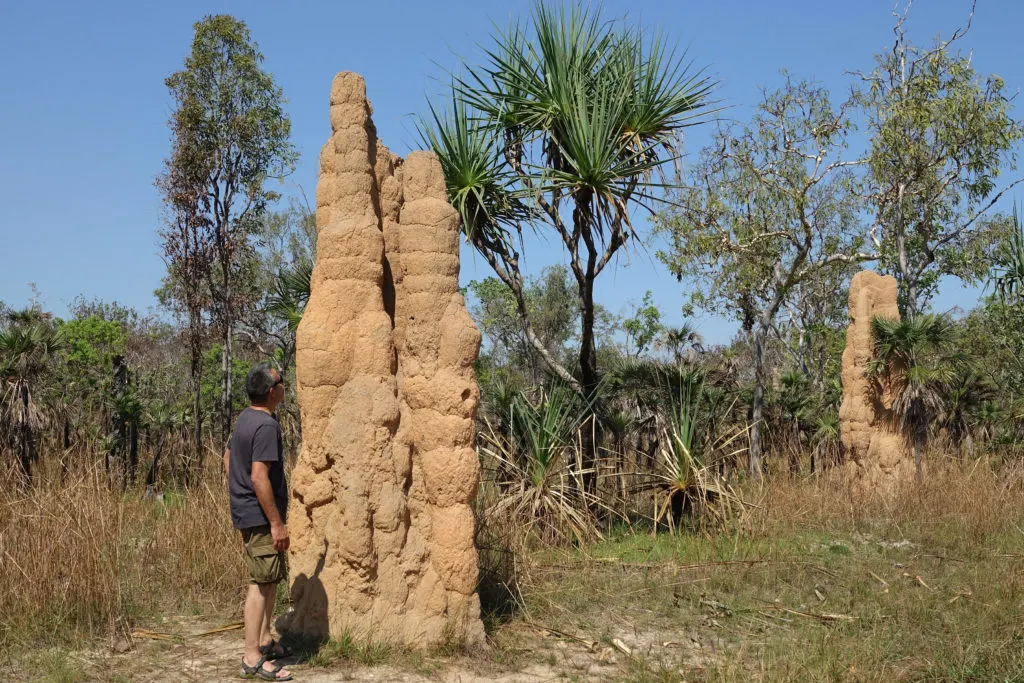
Cathedral Termite Mounds
The Cathedral mounds are much bigger and do look a lot like cathedrals. They have a nice almost terracotta color too.
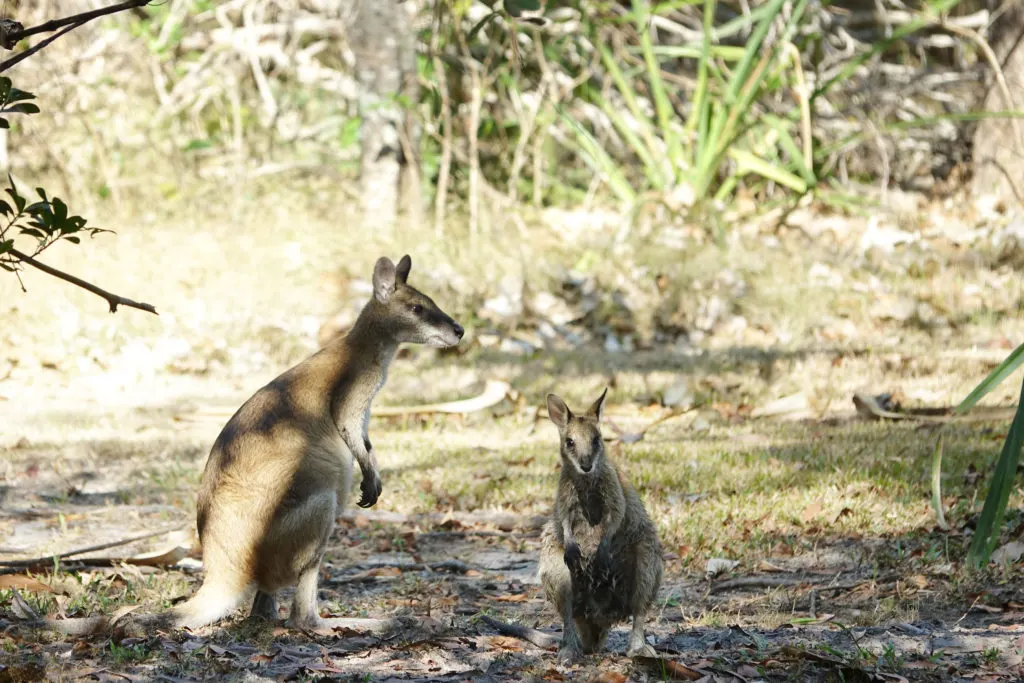
Birdwatching and Other Wildlife Viewing
We saw a few wallabies and saw and heard lots of birds. Birdwatching is popular in Litchfield National Park and the park’s website even has a downloadable birdwatching checklist.
More Great Things to Do in Litchfield National Park
With more time, here are more things to consider:
- Tjaetaba Falls: take the walk from Greenant Creek to the lookout at the top of Tjaetaba Falls. It’s a 2.7 km return track (round trip) and takes about 1.5 hours.
- Florence Creek walk: this 3.2 km walk goes between Florence Falls and Buley Creek and takes about 90-minutes. Start at either end and follow the trail through a cool monsoon rainforest and open savannah woodland. You can swim in both the Florence Falls plunge pool and Buley Rockhole.
- Lost City: this is a group of sandstone outcroppings that resemble an ancient city. It’s remote and requires 4WD. During our visit, Lost City was closed.
- Bushwalking: Tabletop Track is a 39 km circuit bush walk. It’s rated moderate to difficult and takes 3-5 days. It’s for fit, well-prepared, and experienced bushwalkers and requires advanced reservations. See Litchfield Park’s description and requirements and downloadable map.
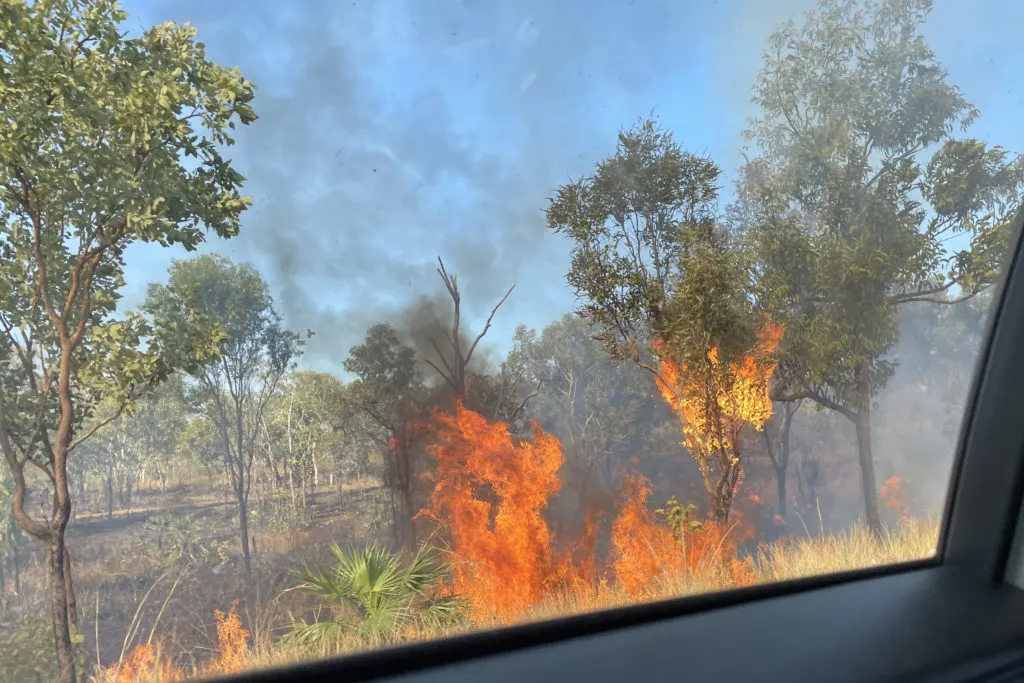
Custodians of This Landscape
We saw many intentionally set fires like this. The Aboriginal people know it’s better to regularly burn off dry grass and brush rather than to let it build up and become a raging wildfire. They have wisely used fire to help manage these lands for thousands of years.
Please stay out of areas that are designated as sacred to the Aboriginal people. The Koongurrukun, Mak Mak Marranunggu, Werat, and Warray Aboriginal people are the custodians who nurture and protect this ancient landscape. The spirits of their ancestors formed the landscape and are still here.
Conclusion
After our quick swing through Litchfield National Park, we spent two great days in Kakadu National Park where we took a Yellow Water Cruise and visited rock art sites and billabongs. These were last minute add-ons to a long-planned-trip through the Red Center on The Ghan train plus a day trip to Uluru (Ayers Rock).
I would have loved more time in Litchfield and hope, someday, to come back and finish the walk from Greenant Creek to Tjaetaba Falls and take some of the other walks as well.
Author bio: Ginny Vail is a travel writer, who loves sightseeing, photography, and videography. She’s been to 45 countries across six continents and traveled by air, car, bus, train, boat, and ship. Her articles can help you discover places to go, sights to see, and details about when and how to visit them.

